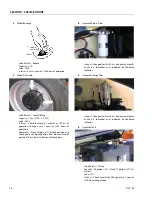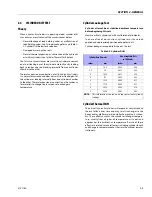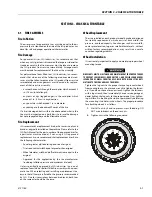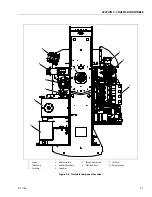
SECTION 2 - GENERAL
2-4
3121160
2.3
LUBRICATION AND INFORMATION
Hydraulic System
1.
The primary enemy of a hydraulic system is contamina-
tion. Contaminants enter the system by various means,
e.g., using inadequate hydraulic oil, allowing moisture,
grease, filings, sealing components, sand, etc., to enter
when performing maintenance, or by permitting the
pump to cavitate due to insufficient system warm-up or
leaks in the pump supply (suction) lines.
2.
The design and manufacturing tolerances of the compo-
nent working parts are very close, therefore, even the
smallest amount of dirt or foreign matter entering a sys-
tem can cause wear or damage to the components and
generally results in faulty operation. Every precaution
must be taken to keep hydraulic oil clean, including
reserve oil in storage. Hydraulic system filters should be
checked, cleaned, and/or replaced as necessary, at the
specified intervals required in the Lubrication Chart in
Section 1. Always examine filters for evidence of metal
particles.
3.
Cloudy oils indicate a high moisture content which per-
mits organic growth, resulting in oxidation or corrosion.
If this condition occurs, the system must be drained,
flushed, and refilled with clean oil.
4.
It is not advisable to mix oils of different brands or types,
as they may not contain the same required additives or
be of comparable viscosities. Good grade mineral oils,
with viscosities suited to the ambient temperatures in
which the machine is operating, are recommended for
use.
NOTE:
Metal particles may appear in the oil or filters of new
machines due to the wear-in of meshing components.
Hydraulic Oil
1.
Refer to Section 1 for recommendations for viscosity
ranges.
2.
JLG recommends Mobilfluid 424 hydraulic oil, which has
an SAE viscosity of 10W-30 and a viscosity index of 152.
NOTE:
Start-up of hydraulic system with oil temperatures below -
15 degrees F (-26 degrees C) is not recommended. If it is
necessary to start the system in a sub-zero environment, it
will be necessary to heat the oil with a low density, 100VAC
heater to a minimum temperature of -15 degrees F (-26
degrees C).
3.
The only exception to the above is to drain and fill the
system with Mobil DTE 13 oil or its equivalent. This will
allow start up at temperatures down to -20 degrees F (-
29 degrees C). However, use of this oil will give poor per-
formance at temperatures above 120 degrees F (49
degrees C). Systems using DTE 13 oil should not be oper-
ated at temperatures above 200 degrees F (94 degrees
C) under any condition.
Changing Hydraulic Oil
1.
Filter elements must be changed after the first 50 hours
of operation and every 300 hours thereafter. If it is nec-
essary to change the oil, use only those oils meeting or
exceeding the specifications appearing in this manual. If
unable to obtain the same type of oil supplied with the
machine, consult local supplier for assistance in select-
ing the proper equivalent. Avoid mixing petroleum and
synthetic base oils.
2.
Use every precaution to keep the hydraulic oil clean. If
the oil must be poured from the original container into
another, be sure to clean all possible contaminants from
the service container. Always clean the mesh element of
the filter and replace the cartridge any time the system
oil is changed.
3.
While the unit is shut down, a good preventive mainte-
nance measure is to make a thorough inspection of all
hydraulic components, lines, fittings, etc., as well as a
functional check of each system, before placing the
machine back in service.
Lubrication Specifications
Specified lubricants, as recommended by the component
manufacturers, are always the best choice, however, multi-pur-
pose greases usually have the qualities which meet a variety of
single purpose grease requirements. Should any question
arise, regarding the use of greases in maintenance stock, con-
sult your local supplier for evaluation. Refer to Section 1 for an
explanation of the lubricant key designations appearing in the
Lubrication Chart.
Summary of Contents for 740AJ
Page 2: ......
Page 55: ...SECTION 3 CHASSIS TURNTABLE 3121160 3 3 This page left blank intentionally...
Page 116: ...SECTION 3 CHASSIS TURNTABLE 3 64 3121160 Figure 3 44 Swing Hub Prior to SN 0300074383...
Page 203: ...SECTION 3 CHASSIS TURNTABLE 3121160 3 151 Figure 3 77 EFI Component Location...
Page 206: ...SECTION 3 CHASSIS TURNTABLE 3 154 3121160 Figure 3 78 ECM EPM Identification ECM EPM...
Page 224: ...SECTION 3 CHASSIS TURNTABLE 3 172 3121160 Figure 3 83 Deutz EMR 2 Troubleshooting Flow Chart...
Page 228: ...SECTION 3 CHASSIS TURNTABLE 3 176 3121160 Figure 3 87 EMR 2 Engine Plug Pin Identification...
Page 229: ...SECTION 3 CHASSIS TURNTABLE 3121160 3 177 Figure 3 88 EMR 2 Vehicle Plug Pin Identification...
Page 230: ...SECTION 3 CHASSIS TURNTABLE 3 178 3121160 Figure 3 89 EMR2 Fault Codes Sheet 1 of 5...
Page 231: ...SECTION 3 CHASSIS TURNTABLE 3121160 3 179 Figure 3 90 EMR2 Fault Codes Sheet 2 of 5...
Page 232: ...SECTION 3 CHASSIS TURNTABLE 3 180 3121160 Figure 3 91 EMR2 Fault Codes Sheet 3 of 5...
Page 233: ...SECTION 3 CHASSIS TURNTABLE 3121160 3 181 Figure 3 92 EMR2 Fault Codes Sheet 4 of 5...
Page 234: ...SECTION 3 CHASSIS TURNTABLE 3 182 3121160 Figure 3 93 EMR2 Fault Codes Sheet 5 of 5...
Page 303: ...SECTION 4 BOOM PLATFORM 3121160 4 31 Figure 4 20 Rotator Assembly HELAC...
Page 460: ...SECTION 5 BASIC HYDRAULIC INFORMATION AND SCHEMATICS 5 116 3121160 NOTES...
Page 467: ...SECTION 6 JLG CONTROL SYSTEM 3121160 6 7 Figure 6 2 ADE Block Diagram...
Page 534: ...SECTION 6 JLG CONTROL SYSTEM 6 74 3121160 NOTES...
Page 580: ...SECTION 7 BASIC ELECTRICAL INFORMATION SCHEMATICS 7 46 3121160 NOTES...
Page 581: ......



































